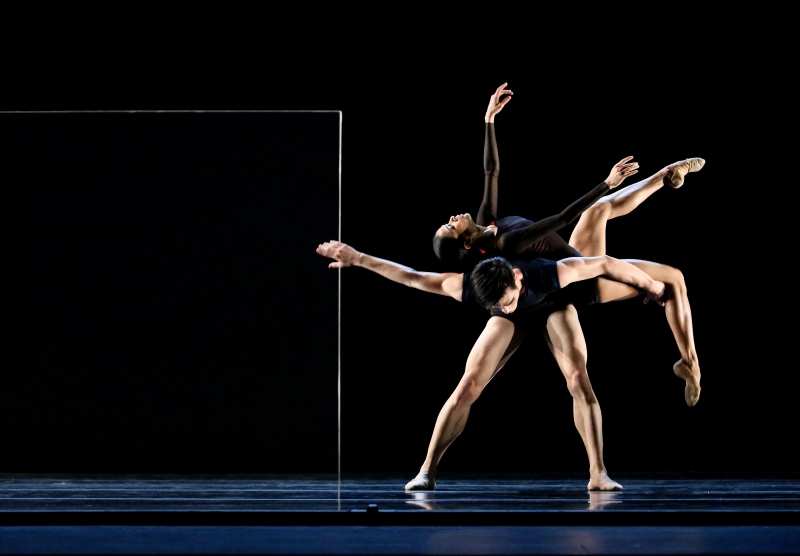Signature talent
Tulsa Ballet's latest series is exquisite

COURTESY Tulsa Ballet
Dance doesn’t play by the rules of rational thought. Instead, it invites us to listen to the language of bodies: not sense-making, but blood and form, memory and gesture. Watching dance is about riding a primal level of consciousness, one that’s been guided and beguiled by the art of a choreographer and given full embodiment by the dancers.
Many choreographers, like George Balanchine, who launched ballet from the Old World into the New in the 1930s, begin their explorations with music—another non-linguistic art. His “Serenade,” which opened Tulsa Ballet’s exquisite “Signature Series” program last week, roots its transcendence in Tchaikovsky’s “Serenade for Strings," a music rich in tension that yearns for resolution.
This, Balanchine’s first American ballet, strips bare the conventions of classical dance, revealing them anew on an empty stage flooded with moonlight and women. The writer Toni Bentley calls it “live geometry, a Euclidean art,” which “illustrates a dancer's trajectory, a woman's inclined ascent.”
It’s thirty minutes of sheer wonder. On opening night, the dancers’ demeanor was more funereal than rapt, with a square musicality and a determined doing of the (incredibly fast, incredibly demanding) steps. The next night, everyone had relaxed a little. More poetry emerged. In both showings, the twenty women and six men moved nearly flawlessly through Balanchine’s iconic choreography, emphasizing its cresting energy and letting us feel the relief in familiar formations.
I loved demi-soloist Jennifer Grace’s plush lines in the closing Elegy and corps de ballet member Julie Marquet’s nobility in the opening Sonatina. Leading dancers Youhee Son and Madalina Stoica could have connected more with the ensemble and used less force with the ballet’s haunting naturalistic moments: the back of a wrist on a forehead, a fall, a backbend that looks like a little death (with a “dark angel,” as the role is known, appearing from behind). It’s not all tulle and satin, this moonlit serenade. It’s a tribe of sisters, an interior evocation, a rite of return.
The charming sextet “Remansos,” all cleverness and longing, made a fine counterpoint to “Serenade.” European contemporary choreographer Nacho Duato’s dances are full of deadpan physical wit, a sort of self-aware clowning that swings easily into leggy earnestness and back again. On opening night, it was Cavan Conley who caught that swing just right: rich, risky, and full of imagination.
The Saturday cast showed impressive clarity and playfulness, with the women in particular (Grace, Jaimi Cullen, and Beatrice Sebelin) giving perfectly articulated weight to every detail. Rodrigo Hermesmeyer, one of TB’s most honest performers, filled the stage with the sweet danger of a young man at play, and Joao Sampaio matched him step for step.
“Infra,” the final work on the program and an Oklahoma premiere—choreographed by Wayne McGregor (who made Thom Yorke’s dance in Radiohead’s “Lotus Flower” video) with LED animations by Julian Opie and heartrending music by Max Richter—is a work of both visual art and dance. Created in the wake of the 2005 London subway bombing, it’s a huge dark landscape, often suddenly bright with detail.
Across the stage-wide screen that hangs above the dancers walks a parade of faceless figures outlined in white. Below (that’s what “infra” means), it’s Rembrandt’s world: warm skin and tangled bodies lit in high contrast, visceral duets showing entrapment and harmony and escape, and big-city bustle out of which sometimes breaks a single dancer with potent emotion.
Tulsa Ballet is one of five companies in the world McGregor allows to perform “Infra,” and the 12 dancers in both casts I saw gave their all in supreme devotion to its challenging movement language—full of distortion, ever-shifting.
On Saturday night, that commitment was present from the beginning in Matteo Manzoni’s gentle smile as he quietly researched a series of ellipses with his elbows and ribcage. Arman Zazyan appeared in a haze of aural static, shirtless and roiling, gradually building a music of his own that made me sit forward in my seat. And Sebelin brought the evening to a wrecking, ravishing climax, giving the best performance of her career as a woman who understands the fleeting preciousness of each pulse of life that passes her.
This program tracks the current step in the evolution of ballet. In a world where nothing is worth anything, anything can be worth everything. There’s no more Euclidean ideal, “Infra” seems to say. There’s technology, there’s darkness, and there’s us. We must find the beauty.
Tulsa Ballet
“Signature Series”
May 5-8 and 13-15
Lorton Performance Center at TU
tulsaballet.org
For more from Alicia, check out her profile of wunderkind playwright Jack Allen.




.jpg)
.jpg)
